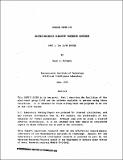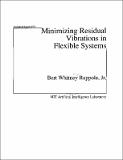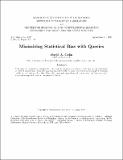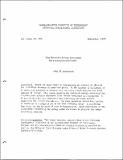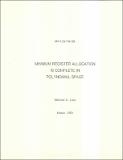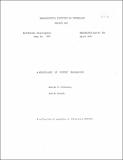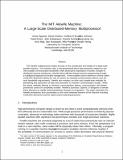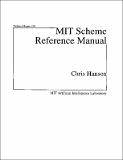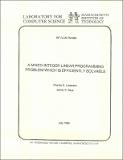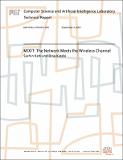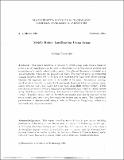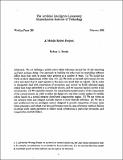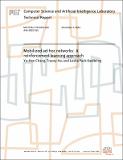Browsing Computer Science and Artificial Intelligence Lab (CSAIL) by Title
Now showing items 2027-2046 of 3804
-
Mini-Robot Group User's Guide Part 1: The 11/45 System
(MIT Artificial Intelligence Laboratory, 1978-06)This USER'S GUIDE is in two parts. Part 1 describes the facilities of the mini-robot group 11/45 and the software available to persons using those facilities. It is intended for those writing their own programs to be run ... -
Mini-Robot Group User's Guide Part 2: Access From ITS
(MIT Artificial Intelligence Laboratory, 1978-06)Part 2 of the MINI-ROBOT USER'S GUIDE describes those devices attached to the mini-robot system which may be accessed from ITS, and describes the appropriate software for accessing them. Specifically, the photowriter, ... -
Mini-Robot Proposal to ARPA
(1972-01-01)During the next decade it will become practical to use more and more sophisticated techniques of automation--we shall call this "robotics"--both in established industries and in new areas. The rate at which these techniques ... -
Minimax Optimal Universal Codeword Sets
(1982-01)In an interactive multi-user data-processing system a user knows the probabilities of his messages and must encode them into a fixed system-wide variable-length codeword set. He needs to receive the answer to his last ... -
Minimizing Residual Vibrations in Flexible Systems
(1992-06-01)Residual vibrations degrade the performance of many systems. Due to the lightweight and flexible nature of space structures, controlling residual vibrations is especially difficult. Also, systems such as the Space ... -
Minimizing Statistical Bias with Queries
(1995-09-01)I describe an exploration criterion that attempts to minimize the error of a learner by minimizing its estimated squared bias. I describe experiments with locally-weighted regression on two simple kinematics problems, ... -
Minimizing the Naming Facilities Requiring Protection in a Computing Utility
(1975-09)This thesis examines the various mechanisms for naming the information objects stored in a general-purpose computing utility, and isolates a basic set of naming facilities that must be protected to assure complete control ... -
The Minimum Energy Movement for a Spring Muscle Model
(1977-09-01)There are many ways of programming an actuator or effector for movement between the same two points. In the interest of efficiency it is sometimes desirable to program that trajectory which requires the least amount ... -
Minimum Register Allocation is Complete in Polynomial Space
(1979-03)The Minimum Register Allocation Problem is to determine the minimum number of registers required to evaluate an arithmetic expression. A pebble game on directed acyclic graphs is used to prove that this is complete is ... -
A Miscellaney of Convert Programming
(1967-04-01)CONVERT shares with other programming languages the circumstance that it is was easier to evaluate the language and to learn its uses if it is possible to scrutinize a representative sample of programs which effect typical ... -
The MIT Alewife Machine: A Large-scale Distributed-memory Multiprocessor
(1991-06)The Alewife multiprocessor project focuses on the architecture and design of a large-scale parallel machine. The machine uses a low dimension direct interconnection network to provide scalable communication band-width, ... -
MIT Mobile Robots - What's Next?
(MIT Artificial Intelligence Laboratory, 1987-11)The MIT Mobile Robot Project began in January of 1985 with the objective of building machines that could operate autonomously and robustly in dynamically changing environments. We now have four working robots, each ... -
MIT Scheme Reference Manual
(1991-01-01)MIT Scheme is an implementation of the Scheme programming language that runs on many popular workstations. The MIT Scheme Reference Manual describes the special forms, procedures, and datatypes provided by the ... -
MIT SchMUSE: Class-Based Remote Delegation in a Capricious Distributed Environment
(1993-02-01)MIT SchMUSE (pronounced "shmooz") is a concurrent, distributed, delegation-based object-oriented interactive environment with persistent storage. It is designed to run in a "capricious" network environment, where servers ... -
A Mixed Integer Linear Programming Problem Which is Efficiently Solvable
(1985-07)Efficient algorithms are known for the simple linear programming problem where each inequality is of the form xj-xi<=aij. Furthermore, these techniques extend to the integer linear programming variant of the problem. This ... -
MIXIT: The Network Meets the Wireless Channel
(2007-09-04)The traditional contract between the network and the lower layers states that the network does routing and the lower layers deliver correct packets. In a wireless network, however, different nodes may hear most bits in a ... -
ML with Extended Pattern Matching and Subtypes
(1989-08)We extend a fragment of the programming language ML by incorporating a more general form of record pattern matching and providing for user-declared subtypes. Together, these two enhancements may be used to support a ... -
Mobile Robot Localization Using Sonar
(1985-01-01)This paper describes a method by which range data from a sonar or other type of rangefinder can be used to determine the 2-dimensional position and orientation of a mobile robot inside a room. The plan of the room is ... -
A Mobile Robot Project
(MIT Artificial Intelligence Laboratory, 1985-02)We are building a mobile robot which will roam around the AI lab observing and later perhaps doing. Our approach to building the robot and its controlling software differs from that used in many other projects in a number ... -
Mobilized ad-hoc networks: A reinforcement learning approach
(2003-12-04)Research in mobile ad-hoc networks has focused on situations in whichnodes have no control over their movements. We investigate animportant but overlooked domain in which nodes do have controlover their movements. ...

